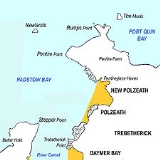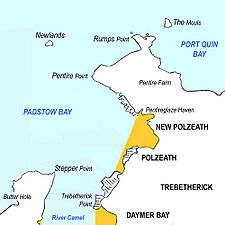
Pentire Point
Encyclopedia

Headlands and bays
Headlands and bays are two related features of the coastal environment.- Geology and geography :Headlands and bays are often found on the same coastline. A bay is surrounded by land on three sides, whereas a headland is surrounded by water on three sides. Headlands are characterized by high,...
and peninsula on the Atlantic
Atlantic Ocean
The Atlantic Ocean is the second-largest of the world's oceanic divisions. With a total area of about , it covers approximately 20% of the Earth's surface and about 26% of its water surface area...
coast in North Cornwall
Cornwall
Cornwall is a unitary authority and ceremonial county of England, within the United Kingdom. It is bordered to the north and west by the Celtic Sea, to the south by the English Channel, and to the east by the county of Devon, over the River Tamar. Cornwall has a population of , and covers an area of...
, England
England
England is a country that is part of the United Kingdom. It shares land borders with Scotland to the north and Wales to the west; the Irish Sea is to the north west, the Celtic Sea to the south west, with the North Sea to the east and the English Channel to the south separating it from continental...
, UK
United Kingdom
The United Kingdom of Great Britain and Northern IrelandIn the United Kingdom and Dependencies, other languages have been officially recognised as legitimate autochthonous languages under the European Charter for Regional or Minority Languages...
and is approx one mile square. The headland projects north-west with Pentire Point at its north-west corner and The Rumps
The Rumps
The Rumps is a twin-headland promontory at the north-east corner of Pentire Head in north Cornwall, United Kingdom.The promontory is formed from hard basaltic rock and projects north into the Atlantic Ocean. Its headlands lie east-to-west...
promontory at its north-east corner.
Etymology
The origin of the name is from Cornish pen (head) and tir (land): another headland with the name Pentire is further west near CrantockCrantock
Crantock is a coastal civil parish and a village in Cornwall, England, United Kingdom. The village is approximately two miles southwest of Newquay....
.
Geography
Pentire Point and Stepper PointStepper Point
Stepper Point is a headland on the Atlantic coast in north Cornwall, England, UK.Stepper Point and Pentire Point stand at either side of the mouth of the River Camel; Stepper to the south-west, Pentire to the north-east....
stand at either side of the mouth of the River Camel
River Camel
The River Camel is a river in Cornwall, UK. It rises on the edge of Bodmin Moor and together with its tributaries drains a considerable part of North Cornwall. The river issues into the Celtic Sea area of the Atlantic Ocean between Stepper Point and Pentire Point having covered a distance of...
estuary (Pentire to the north-east, Stepper to the south-west). To the south of Pentire Point is the small seaside resort
Seaside resort
A seaside resort is a resort, or resort town, located on the coast. Where a beach is the primary focus for tourists, it may be called a beach resort.- Overview :...
of Polzeath
Polzeath
Polzeath is a small seaside resort in the civil parish of St Minver in Cornwall, United Kingdom. It is situated approximately six miles north of Wadebridge on the Atlantic coast....
. The coastline around the headland is owned by the National Trust
National Trust for Places of Historic Interest or Natural Beauty
The National Trust for Places of Historic Interest or Natural Beauty, usually known as the National Trust, is a conservation organisation in England, Wales and Northern Ireland...
, although the bulk of the headland itself is let to Pentire Farm.
The Rumps promontory is the site of Iron Age
Iron Age
The Iron Age is the archaeological period generally occurring after the Bronze Age, marked by the prevalent use of iron. The early period of the age is characterized by the widespread use of iron or steel. The adoption of such material coincided with other changes in society, including differing...
clifftop fortifications - the series of mound and ditch earthworks remain clearly visible today.
The entire headland forms the Pentire Peninsula Site of Special Scientific Interest
Site of Special Scientific Interest
A Site of Special Scientific Interest is a conservation designation denoting a protected area in the United Kingdom. SSSIs are the basic building block of site-based nature conservation legislation and most other legal nature/geological conservation designations in Great Britain are based upon...
, designated for its geology
Geology of Cornwall
The Geology of Cornwall is dominated by its granite backbone, part of the Cornubian batholith, formed during the Variscan orogeny. Around this is an extensive metamorphic aureole formed in the mainly Devonian slates that make up most of the rest of the county...
and flora and fauna
Flora and fauna of Cornwall
Cornwall is the county that forms the tip of the southwestern peninsula of England; this area has a mild and warm climate regulated by the Gulf Stream...
including nationally rare plants. Important examples noted include slate
Slate
Slate is a fine-grained, foliated, homogeneous metamorphic rock derived from an original shale-type sedimentary rock composed of clay or volcanic ash through low-grade regional metamorphism. The result is a foliated rock in which the foliation may not correspond to the original sedimentary layering...
s from the Upper Devonian period
Devonian
The Devonian is a geologic period and system of the Paleozoic Era spanning from the end of the Silurian Period, about 416.0 ± 2.8 Mya , to the beginning of the Carboniferous Period, about 359.2 ± 2.5 Mya...
, several invertebrate
Invertebrate
An invertebrate is an animal without a backbone. The group includes 97% of all animal species – all animals except those in the chordate subphylum Vertebrata .Invertebrates form a paraphyletic group...
species, predatory birds
Bird of prey
Birds of prey are birds that hunt for food primarily on the wing, using their keen senses, especially vision. They are defined as birds that primarily hunt vertebrates, including other birds. Their talons and beaks tend to be relatively large, powerful and adapted for tearing and/or piercing flesh....
and grey seal
Grey Seal
The grey seal is found on both shores of the North Atlantic Ocean. It is a large seal of the family Phocidae or "true seals". It is the only species classified in the genus Halichoerus...
s.
A small island named Newland lies about one mile (1,600 metres) to the north-west of Pentire Point. Another small island named The Mouls lies 300 yards to the north-east of The Rumps and supports colonies of seabirds. Beyond The Rumps, the coastline veers southeast into Port Quin
Port Quin
Port Quin is a small cove and hamlet between Port Isaac and Polzeath on the Atlantic coast in north Cornwall, England, UK.The hamlet and the coastline is mainly owned by the National Trust for Places of Historic Interest or Natural Beauty; the Trust rents out several of the stone cottages as...
Bay.
The South West Coast Path
South West Coast Path
The South West Coast Path is Britain's longest waymarked long-distance footpath and a National Trail. It stretches for , running from Minehead in Somerset, along the coasts of Devon and Cornwall, to Poole Harbour in Dorset. Since it rises and falls with every river mouth, it is also one of the more...
closely follows the coastline of the headland, and sightseeing boat tours regularly travel along the coast from the nearby port of Padstow
Padstow
Padstow is a town, civil parish and fishing port on the north coast of Cornwall, England, United Kingdom. The town is situated on the west bank of the River Camel estuary approximately five miles northwest of Wadebridge, ten miles northwest of Bodmin and ten miles northeast of Newquay...
.
For The Fallen

Laurence Binyon
Robert Laurence Binyon was an English poet, dramatist and art scholar. His most famous work, For the Fallen, is well known for being used in Remembrance Sunday services....
wrote For The Fallen (first published in The Times
The Times
The Times is a British daily national newspaper, first published in London in 1785 under the title The Daily Universal Register . The Times and its sister paper The Sunday Times are published by Times Newspapers Limited, a subsidiary since 1981 of News International...
in September, 1914) while sitting by the cliffs between Pentire Point and The Rumps. A stone plaque was erected in 2001 to commemorate the fact and bears the inscription
- For The Fallen
- Composed on these cliffs 1914
The plaque also bears the fourth stanza of the poem:
- They shall grow not old, as we that are left grow old
- Age shall not weary them, nor the years condemn
- At the going down of the sun and in the morning
- We will remember them
External links
- Pentire Point at Polzeath
- Photographs and information from Strolling Guides

